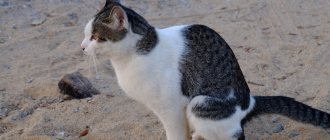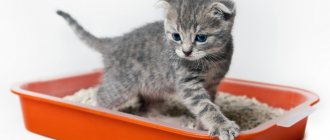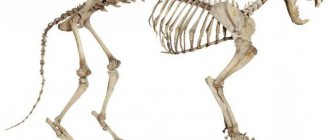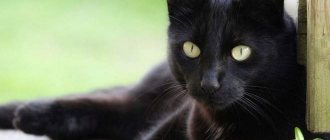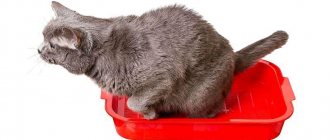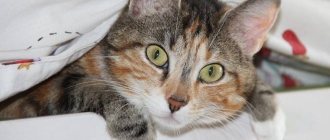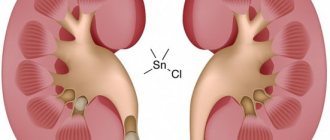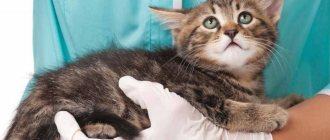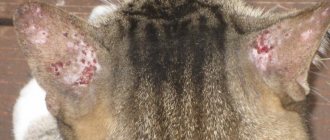Loose stool with blood in a cat is a fairly common pathology that occurs in many pets. Therefore, owners of furry purrs should not immediately panic and think about the worst.
For example, if a cat eats too much dry food or foods that cause constipation, then constipation is the cause of a prolonged act of defecation, during which hemorrhoids appear, and hence bloody stools. Relieving constipation in a cat is easy. If you don't give her foods that cause it, then the blood will completely disappear.
But, if you notice for a long time that blood periodically appears in your cat’s stool or that the volume of blood is quite large, then it’s time to sound the alarm. This factor indicates the onset of the development of a very serious disease.
Often, blood in the stool of a domestic cat indicates hematochezia, a disease in which fresh blood appears in the animal’s stool. Hematochezia is characterized by heavy bleeding in the intestine and its lower part. This disease should not be confused with melena, a disease characterized by the presence of black stool.
Hematochezia, as a disease, is easily recognized by the character of the cat - the animal is weak, lethargic, does not eat or drink anything, and often runs to the toilet. If you have these and other symptoms, contact your veterinarian immediately.
Symptoms of diarrhea in cats
Diarrhea in a domestic cat cannot go unnoticed. When the stool is upset, the pet often visits the litter box and goes to the toilet loosely. In this case, feces may have a foul odor and a different consistency - watery, mushy, mixed with mucus and blood.
Stools with diarrhea come in different colors - yellow, black, greenish and even white. It is important to monitor the clinical picture, as additional symptoms will help to accurately establish the diagnosis. Loose stools in a cat are often accompanied by a general deterioration in health:
- loss of appetite;
- oppression;
- increased temperature;
- vomiting;
- rapid weight loss.
Attention! Diarrhea with vomiting is especially dangerous in a kitten, in which fluid loss occurs very quickly. In such a situation, the pet needs urgent help.
It also matters how long the loose stool lasts. There are 3 types of diarrhea:
- acute – duration 1–2 days;
- chronic – more than a week;
- intermittent or recurrent - diarrhea occurs periodically.
Clinical picture
To know what to do if your cat has diarrhea with blood and mucus, you need to understand where the bleeding occurred in the gastrointestinal tract.
If the inflammation is localized in the stomach and small intestine, the liquid stool turns black and lacks mucus, and vomiting and gas formation are also possible. When the large intestine is damaged, the diarrhea contains streaks of scarlet blood with mucus. The cat does not have vomiting or flatulence.
Owners need to pay attention to these signs to help the attending physician understand the causes of bloody diarrhea in a cat.
Symptoms that require immediate medical attention
You should not try to do anything on your own if your cat’s diarrhea with blood is accompanied by the following symptoms:
- a sharp decrease in body temperature below acceptable values;
- temperature rise above 41 °C;
- frequent vomiting mixed with blood and bile;
- severe tension in the abdominal wall;
- fetid, putrid odor emanating from feces;
- nervous phenomena.
In these cases, it is necessary to treat bloody diarrhea in cats only in a clinical setting.
Types of diarrhea and preliminary diagnosis by stool color
If your cat is diarrhea, you need to pay attention to the color and structure of the stool. This will help clarify the clinical picture and make the correct diagnosis.
Any information is important to make a diagnosis
Loose stools happen:
- watery;
- Green colour;
- white;
- black;
- yellow;
- with mucus;
- with blood.
Diarrhea with water
Watery stool of normal color should not cause concern if diarrhea occurs 1-2 times. This sometimes happens due to a sudden change in diet, under stress, for example, after a trip to the veterinarian or after moving. A kitten has diarrhea with water due to the introduction of new food into the diet. Babies' intestines are weak; any changes in the menu can cause bowel upset.
Green diarrhea in a domestic cat
Feces acquire a greenish tint when pathogenic microflora develops in the intestines. Putrefactive processes can begin due to eating low-quality, spoiled food or due to dysbiosis. This is a potentially dangerous situation as harmful bacteria in the digestive tract continue to multiply and release toxins, poisoning the entire body. You need veterinarian help if diarrhea lasts more than 2 days.
Greenish stool with mucus
White diarrhea in a cat
White, loose stool in a pet is a reason to contact a veterinary clinic. Such feces indicate serious problems with the liver and gallbladder. Discoloration of stool is often caused by difficulty producing bile. Even if your cat has white diarrhea only once, you should not put off visiting the veterinarian.
Black liquid stool
The stool color is too dark if the animal eats a lot of iron-containing food - raw meat with blood, or takes iron supplements. Otherwise, black stools indicate internal bleeding. It can occur for various reasons, for example:
- as a result of a blow or fall from a height;
- due to helminthic infestation;
- with hemorrhagic gastroenteritis;
- due to a tumor in the intestine.
Yellow diarrhea
Light brown or yellowish runny stool is a common occurrence in pets. This color of feces indicates that food is poorly digested. Too bright a shade of yellow may indicate liver problems. Perhaps your pet ate something fatty or drank a lot of milk. Having discovered such a symptom, it is best to put the cat on a starvation diet for 8–12 hours and observe him. If the diarrhea does not stop, you will have to undergo tests to identify liver pathologies.
With blood or mucus
Blood in the stool is a warning sign. Sometimes the cause of this symptom is a foreign body that the pet has swallowed. As it moves through the intestines, it can damage its wall, hence the blood. Other reasons for the appearance of bloody streaks are inflammation of the intestinal mucosa, cracks inside the anus.
Mucus in stool
Diarrhea with mucus indicates infection with worms. A large amount of mucous secretion in the feces is detected after deworming.
Diarrhea and vomiting
When food or chemical poisoning occurs, cats develop diarrhea and vomiting. This condition can also be caused by an infectious disease or heat stroke. The body becomes dehydrated very quickly, so emergency assistance is needed. To replenish the fluid balance in the body, you need to water the cat or inject a glucose solution under its withers.
How to treat a cat with bloody stools
Remove dry food from your cat's diet. And do this immediately if you notice even the slightest drops of blood in the animal’s feces. Canned dry food is harmful to the health of any cat, and it is especially harmful for purebred cats.
Cat food is the same as “fast food” for us. If we only eat such food, we risk getting a stomach ulcer. Likewise, a cat that is constantly fed nothing with dry food runs the risk of developing urolithiasis or gastrointestinal disease.
So, what to do first if you notice bloody feces in your cat - pour the dry food into the trash can and start feeding the cat a balanced meal, not table scraps, but your own, home-cooked food.
In this case, milk and dairy products should also be excluded from the cat’s diet, and only diet food should be given – without cat canned foods and fatty meats. You can give boiled chicken breast, chicken legs, thighs. Try to force the cat to eat a little boiled rice, twisted through a blender, as it strengthens the intestines well.
The usual “Smecta” helps to overcome hard stool and blood in a cat’s feces, if, among other things, the animal’s bowel movements are rare and mucous. If a week-long course of Smecta did not help, then ask your veterinarian what else he can do to help the poor cat.
Many veterinarians prescribe the hepatoprotector Elvestin or Liarsin - stick to the course of homeopathic medicines, give up dry food completely, and your cat will feel much better. In just a week, your pet will feel better and its digestive organs will return to normal.
It is very important during an exacerbation of the disease, when blood is detected in the cat’s stool, to prescribe a meal rich in fiber. Meals should contain food consisting of complete proteins and fats. By changing your cat's diet, you will thereby relieve the animal from many problems, most likely caused by its individual food intolerance.
Even if, after you completely change your cat’s diet, there is still blood in the feces, take the animal to a veterinarian immediately. He will immediately conduct numerous studies and prescribe a course of medications, which your pet must adhere to for the entire period of the disease diagnosed in him.
To get rid of a parasitic or bacterial infection, experienced veterinarians often prescribe antibiotics that stimulate the rapid passage of cat food through the intestines.
If the doctor prescribes infusion therapy - injection, do not refuse it under any circumstances. Thanks to this method, the sick cat receives all the nutrients and vitamins it needs to maintain its emaciated body normal.
Therapy treatment
There are cases when a sick purebred cat, who was found to have blood in his stool, was prescribed Contrikal - a 10-day course of drip infusions to support the cat’s intestines. To ensure that the animal’s liver functions normally, you can give the cat Essentiale Forte drops.
Perform infusions into the animal's body by diluting 1 milliliter of the bottle in 20 milliliters of saline solution. As for the drug Essentiale Forte, it must be given to cats under the strict supervision of a veterinarian, so treating the animal yourself is dangerous.
Cats should only be given injections by specialists and at a strictly designated time, and even then not to everyone. Some cats cannot tolerate subcutaneous injections, so in order for an animal to be subjected to such “torture,” it must initially undergo all the necessary laboratory tests.
Naturally, it is rare that you can put your cat through all this, which is why many cat owners do not recommend allowing veterinarians to give subcutaneous injections to their pets. Let them be just ordinary capsules. Mix one capsule a day of Essentiale with food and you will see a noticeable improvement.
Be sure, along with these capsules, to give your sick cat with rare bowel movements with mucus and blood in the stool Hophytol tablets, mixing it with food. Hofitol is a drug that has a choleretic effect.
Restoration of microflora
There was a case when one of the experienced veterinarians suggested that a cat suffering from intestinal mycosis take Hilak Forte drops in order to restore the natural intestinal microflora of the sick cat. It is this drug, which is attributed to people, that helped a cat suffering from dysbacteriosis overcome a fungal infection.
Dysbacteriosis of the intestinal microflora that has arisen in a cat can be easily brought back to normal if you feed it several times a day Hilak Forte, which contains the entire complex of bacteria that help quickly normalize the animal’s digestive acidity.
One lady on a zoological forum told how she was advised to mix Eubicor into her cat’s food. This is a children's prebiotic, which includes all the microelements necessary for microflora. Eubicor is designed to fight dysbiosis and cleanse the intestines. Literally in 3 weeks.
The woman noticed how her cat’s stool returned to normal, and the sour, unpleasant smell of the stool disappeared, as if it had never happened. A repeated analysis of the stool of a domestic cat at a veterinary clinic showed stunning results - the blood in the feces disappeared.
Causes of intestinal distress in pregnant and lactating cats
While carrying kittens, the cat's immune system becomes vulnerable, so she can easily catch a viral or bacterial infection. It is important to monitor the quality of food that the expectant mother receives to minimize the risk of developing diarrhea. A pregnant cat should not be introduced to new foods or given fatty foods, as this can cause bowel upset. Brief diarrhea sometimes occurs a day or two before the onset of labor; this is considered normal.
Cats have diarrhea after giving birth
When diarrhea occurs shortly after lambing, a possible cause is eating the placenta. Changes in hormonal levels also affect the functioning of the intestines, so there is no need to worry about short-term bowel disorders after childbirth.
Attention! Some owners of nursing cats give them a lot of whole milk to drink, which causes loose stools. It is better to replace it with fermented milk products - fermented baked milk, cottage cheese or whey.
Causes of black stool
When the pet is completely healthy, he feels good. If the animal receives a balanced diet, its stool is brown in color and has a medium to dense consistency. Sometimes the shade varies from light to dark tone. If the color of the stool turns black, it means that various changes are occurring in the animal’s body, which can be either non-life-threatening or pathological. Discoloration may occur due to the following reasons:
- deterioration of diet;
- new food products;
- diseases of the gastrointestinal tract or internal organs;
- bleeding;
- consuming foods that contain iron or iron supplements;
- eating raw meat.
If the disease is severe, other signs may appear, which are accompanied by additional symptoms. If the cat looks normal outwardly, then just observing it for a few days is enough.
What to do if your cat has diarrhea
Having discovered that your cat has severe diarrhea without complications, the first thing to do is remove food from his bowl. The drinking bowl should be washed and fresh water added. Your pet needs rest. It is advisable to place it in a separate room. If there are other furry inhabitants in the house, it is better to limit their contact with the sick pet.
The animal's condition should return to normal within 12–24 hours. If the diarrhea does not go away, you need to schedule a visit to the veterinary clinic and go there as soon as possible. These recommendations do not apply to cases where the cat:
- bloody, black, white diarrhea;
- diarrhea accompanied by vomiting;
- increased temperature;
- coordination of movements is impaired;
- convulsions.
Cat examination
Having discovered such symptoms, you cannot wait a day - the animal may die due to internal bleeding, chemical poisoning and intoxication. In these cases, the cat needs to be examined to determine the real cause of the disease. The veterinary clinic will take tests, do an ultrasound of the internal organs and prescribe a treatment regimen. Your pet may need surgery.
Diagnostics
Before treating bloody diarrhea in a cat, it is necessary to accurately determine the cause of its occurrence.
To do this, a veterinarian conducts the following studies:
- collection of anamnestic data;
- examination, including palpation, percussion and auscultation;
- general and clinical blood test;
- examination of feces for the presence of eggs, segments or larvae of helminths;
- instrumental methods (if necessary).
Instrumental methods include:
- radiography;
- endoscopy;
- colonoscopy;
- Ultrasound.
If a veterinarian suspects a malignant tumor causing diarrhea in a cat, he may prescribe a blood test to detect the leukemia virus or immunodeficiency virus, conduct a biopsy followed by tissue histology.
Treating diarrhea in a cat at home
In cases where diarrhea is not complicated by vomiting, high fever, and there are no signs of internal bleeding, it can be cured without the help of specialists. The main rule for intestinal upset is to give you more water to drink. If the animal does not approach the drinking bowl, you will have to unsolder it from the syringe with Regidron solution, removing the needle. There is no need to offer your cat food for the next 24 hours.
Enterosgel
Further, if the condition improves and the interval between bowel movements increases, you can start feeding your pet. Veterinarians recommend giving therapeutic and preventive food for diarrhea. They do not irritate the intestinal mucosa, are easily digested, help eliminate toxins and consolidate stool.
Medicines for cats for diarrhea:
- Smecta. The safest sorbent, approved even for small children. Helps remove intoxication and consolidate feces. A quarter of the sachet is diluted with water and 5 ml is poured into the pet’s mouth from a syringe 4 times a day.
- Bifidumbacterin. Probiotics help normalize intestinal microflora and are absolutely harmless. The contents of the bottle are diluted with water (5 ml) and given to the pet to drink.
- Activated carbon. A sorbent that everyone has in their home. Effectively fights poisoning and removes toxic substances from the body. Dissolve ¼ tablet in a small amount of water. Give your cat a drink in the morning and evening.
- Enterosgel. New generation sorbent. Effective against intestinal infections, as it prevents the proliferation of pathogenic bacteria. Directions for use: squeeze 0.5 cm of gel out of the tube and dilute it in a tablespoon of water. Give your pet 3–5 ml 3 times a day.
Attention! Treatment of diarrhea in a cat at home cannot last more than 1–2 days. If symptoms persist, consult a veterinarian. Perhaps diarrhea is caused by a viral infection or pathologies of internal organs. In this case, the doctor will determine the treatment regimen.
Therapy
Bloody diarrhea in cats should be treated by a veterinarian, as the animal may require urgent surgical care or intravenous injections.
The general principles of therapy are:
- diet;
- preventing dehydration with intravenous or subcutaneous injections of Ringer's solution with glucose;
- maintaining heart function (caffeine benzoate, cordiamine);
- mechanical washing out of pathogens (in infectious processes) using enemas with decoctions of oak bark and chamomile;
- prevention of bleeding with Vikasol (Dicinone, Etamsylate).
Is it possible to be treated at home?
At home, treatment for bloody diarrhea consists of following a course of therapy prescribed by a veterinarian, as well as following a strict diet. The following foods are excluded from the diet:
- raw meat and fish;
- salted, fried, smoked foods;
- sweets;
- confectionery and bakery products;
- ready-made food below super premium class;
- whole milk, sour cream;
- canned food intended for human consumption;
- cabbage, potatoes, beets.
Important! In some cases, a specialist prescribes a starvation diet. However, it is worth remembering that cats must receive water in the required quantity.
Specialized treatment
Principles of specific therapy for bloody diarrhea depending on the pathology:
| Pathologies | Treatment |
| Viral diseases | Immunostimulants, antibiotics (to prevent the development of bacterial pathogenic microflora) |
| Helminthiasis | Complex anthelmintics, destruction of ectoparasites |
| Poisoning | Sorbents |
| Non-infectious gastrointestinal pathologies | Feeding adjustments |
| Bacterial diseases | Antibiotics |
| Malignant tumors | Surgical removal of tumors, chemotherapy |
| Foreign bodies | Surgical extraction |
| Injuries | Surgical methods |
| Coccidiosis | Coccidiostats, sulfa drugs |
Despite the existence of general principles of therapy, treatment is selected by a veterinary specialist individually for each specific case.
Antibiotics and sulfonamides for diarrhea
Sorbents and probiotics can be given to a cat for diarrhea without a veterinarian's prescription, but with antibiotics and intestinal antiseptics the situation is different. Treatment of diarrhea in infectious diseases is not limited to just relieving symptoms. Complex therapy may be needed, including taking antiviral agents, immunostimulants such as Anandin, Cycloferon, as well as antibacterial or sulfonamide drugs.
Levomycetin
This medicine is effective against gram-positive bacteria - enterococci, streptococci and staphylococci, as well as against gram-negative ones - Escherichia coli and Haemophilus influenzae, Shigella, Salmonella, Klebsiella, etc.
How to give a cat a pill
Levomycetin for cats for diarrhea, dosage: ¼ tablet 2 times a day. The medicine is very bitter, the pet is unlikely to swallow it in its pure form. You can use a trick - hide a quarter of the tablet in a small crumb of bread. The ball is placed on the root of the animal’s tongue, its mouth is closed and the throat area is stroked to provoke a swallowing movement.
Reference. If you cannot give the medicine orally, you can administer it intramuscularly. Your veterinarian will tell you how to dose the drug in this case.
Phthalazole
A sulfanilamide drug with a bacteriostatic effect. Used for enterocolitis caused by intestinal infections. The dose is determined by the weight of the animal - 100 mg of the substance per 1 kg of weight. For a cat weighing 2.5 kg, the daily dose is 250 mg (half a tablet). It must be divided into 3-4 doses. The course of treatment is 4–5 days.
Furazolidone
The nitrofuran drug Furazolidone is given to a pet only as prescribed by a veterinarian. It effectively fights bacteria and fungi in the intestines. Dosage for an animal is 5 mg of the substance per 1 kg of weight. A cat weighing 5 kg is given half a tablet (25 mg) per day, dividing it into 2-3 doses at equal intervals.
Furazolidone
Enterofuril (Nifuroxazide)
Nitrofuran drug for diarrhea of infectious etiology. For the treatment of cats, it is better to use a suspension of 200 mg/5 ml. The daily dose for a pet is 200 mg or 5 ml, it should be divided into 3 doses, 1.7 ml each.
Other antibiotics
The veterinarian may prescribe other antibacterial drugs to treat diarrhea:
- Metronidazole;
- Ciprofloxacin;
- Amoxicillin.
After taking antibiotics, it is necessary to restore the animal's intestinal microflora. Veterinarians recommend giving your pet probiotics - Linex, Bifidumbacterin.
What to feed during diarrhea
Diet for digestive disorders is very important. To alleviate your cat's condition, you should:
- provide plenty of fluids;
- exclude dairy products, and ideally almost all products from the human table;
- introduce a starvation diet for up to twenty-four, and sometimes forty-eight hours for an adult cat, up to twelve hours for a kitten;
- introduce special medicinal food into the diet - many leading manufacturers of food for cats have “gastro” and gastrointensive lines in the form of dry and wet food;
- you can try giving rice water;
- introduce sorbents into the diet;
- sometimes the use of folk remedies helps - decoctions of chamomile, oak bark, St. John's wort;
- introduce probiotics into the diet (Linex, Baktisubtil).
Nutrition during treatment
In case of diarrhea, the cat is not fed in the first 12–24 hours, and drinking is not limited. Feeding can be resumed when the animal develops an appetite and the number of bowel movements decreases. In case of poisoning and infectious diseases accompanied by loose stools, pets are not given food from the table. During illness, they offer canned therapeutic and prophylactic food. The daily dose of food is reduced by 2 times and divided into 5-6 meals. The cat should eat in small portions. Diets are followed throughout the entire course of treatment until complete recovery.
It is very important to replenish fluid loss in your pet's body. The cat needs to drink water; if he refuses, you will have to pour Regidron solution 5-7 ml into his cheek up to 10 times a day. Another way to restore the water-salt balance is to inject sodium chloride and glucose solution subcutaneously, 20-40 ml at a time.
Subcutaneous injection in a cat
Features of the disease
Diarrhea is the rapid evacuation of intestinal contents without proper absorption. At the same time, the number of bowel movements increases to 4 or more times a day, the masses acquire a liquid state.
Such disorders entail dehydration, which can cause lethargy, decreased activity, lack of appetite, etc. In the absence of proper treatment, water and electrolytes are washed out of the body, leading to a serious imbalance and death of the pet.
Bloody diarrhea in cats is a sign of serious damage to the digestive tract. Blood streaks and clots, remnants of undigested food, and worms may be passed along with the stool.
If blood appears in your pet's stool, you must immediately seek help from a veterinarian to diagnose and treat the problem and prevent complications.
Prevention of diarrhea
Most often, diarrhea in domestic cats develops due to dietary errors, so it is important to follow the recommendations of veterinarians:
- feed animals with the same brand of food;
- do not exceed the dosage specified by the manufacturer;
- Do not put too much wet food in the bowl - it may spoil at room temperature;
- Do not give your cat fatty foods - pork, lard, smoked meats;
- You cannot treat your cat with salted fish and raw meat.
Veterinarians recommend deworming twice a year, because worms are one of the causes of diarrhea. To protect your animal from infectious diseases, you should limit contact with street cats and get vaccinated in a timely manner.
The health of a pet largely depends on the quality of its care. The cat owner needs to be attentive, watch her, notice any changes in behavior and well-being and respond to them. Diarrhea that does not stop within one day is a reason to seek veterinary help. Self-medication can lead to a worsening of the situation and even death of the pet.
Causes of bloody diarrhea
Bloody diarrhea in a cat can occur for the following reasons:
- Changing your diet. If you have sensitive digestion, a sudden transition can cause severe intestinal irritation.
- Swallowing inedible objects. If diarrhea begins, you need to carefully monitor your pet. The cause may be eating grass, bones and other objects.
- Allergy. Milk especially often causes bloody diarrhea.
- Parasites. In most cases, the cause of illness is helminths.
- Infectious pathologies. Mucus and blood often appear with intestinal lesions, but other organs can become a source of infection. For example, this happens with bacterial kidney diseases.
- Taking medications. Some drugs irritate mucous membranes.
- Intoxication. Poisoning can occur as a result of consuming detergents.
Sometimes bloody diarrhea is observed with inflammatory diseases of the gastrointestinal tract. The combination of these symptoms is detected in pancreatitis. In some cases, diarrhea and bloody impurities are not related. Clots can be found with ulcerative colitis or Crohn's disease, and digestive disorders can be found with poor diet.
View this post on Instagram
I'm already starting to see something beautiful in all these medicines and tubes. I managed to reduce the diarrhea of cats to minimal inconvenience. Now it is very important to make the stool hard. I constantly consult with the veterinarian (God bless her soul, how can she still tolerate me?) Prices for medicines are now wild, my cats are no longer gold, but platinum. Look at the interesting form of vitamin B12: a small ampoule with red liquid. Do you know that this vitamin comes out during diarrhea and is not synthesized on its own? In short, #integratedapproach
